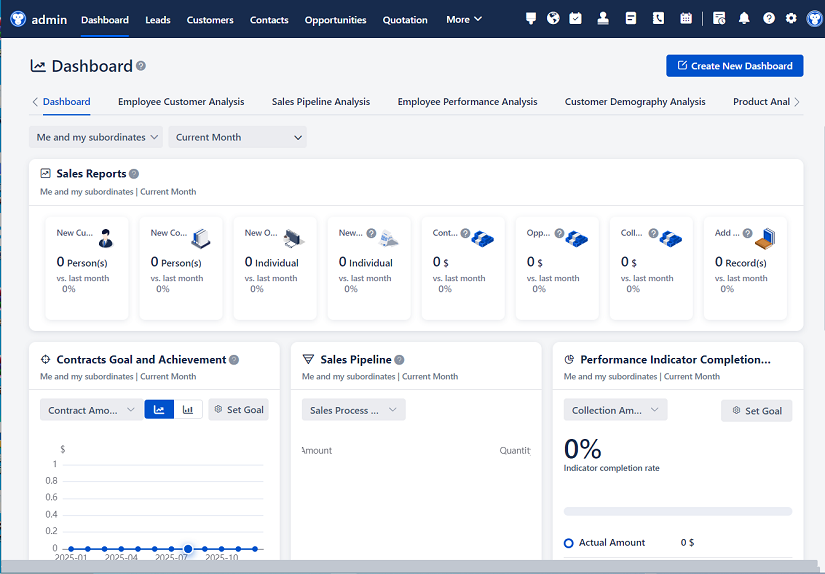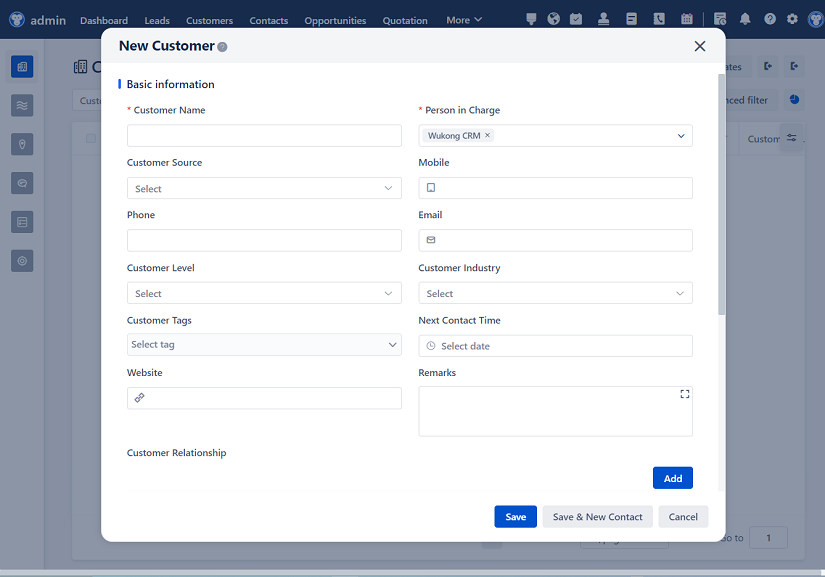
△Click on the top right corner to try Wukong CRM for free
So, let me tell you something — managing customers these days isn’t just about keeping a list of names and sending out the occasional email. It’s way more strategic than that. I mean, think about it: every business wants loyal customers, right? But how do you actually build that kind of relationship in a world where people are constantly bombarded with ads and messages? That’s where CRM — Customer Relationship Management — comes into play. And honestly, if you’re not using a solid CRM strategy, you’re probably missing out on some serious opportunities.

Free use of CRM system: Free CRM
Now, don’t get me wrong — CRM isn’t just software. Sure, tools like Salesforce or HubSpot help, but the real magic happens when you combine technology with smart planning. A good CRM strategy is all about understanding your customers deeply — their behaviors, preferences, pain points — and then using that knowledge to deliver value at every touchpoint. It’s not just about selling; it’s about building trust over time.
Let me give you an example. Imagine you run an online clothing store. Without CRM, you might send the same promotional email to everyone on your list — “20% off everything!” — and hope for the best. But with a proper CRM strategy, you could segment your audience. You’d know that Sarah from Chicago loves sustainable fashion and usually buys during sales, while James in Austin prefers premium denim and shops mostly on weekends. So instead of blasting generic messages, you send Sarah eco-friendly brand highlights and early access to clearance events, and James gets personalized recommendations based on his past purchases. See the difference? One feels random; the other feels personal. And guess which one leads to stronger loyalty?
That’s the power of data-driven customer management. But here’s the thing — collecting data isn’t enough. You’ve got to organize it, analyze it, and act on it. Most companies today have tons of customer information sitting in spreadsheets or siloed systems, but they’re not doing much with it. And that’s a problem. Because if you can’t turn data into insights, you’re basically flying blind.
So how do you start formulating a CRM strategy that actually works? Well, first, you need to define your goals. Are you trying to increase customer retention? Boost average order value? Improve response times in customer service? Your CRM approach will look different depending on what you’re aiming for. For instance, if retention is your focus, you’ll want to track things like repeat purchase rates and customer satisfaction scores. If you’re after upselling, you’ll dive into cross-buying patterns and product affinities.
Once you know your goals, the next step is mapping out the customer journey. This means thinking through every stage — from awareness to consideration, purchase, and beyond. Where do people first hear about you? What makes them decide to buy? How do they feel after the transaction? And most importantly, what keeps them coming back? When you map this out, you start seeing where CRM can make a real impact. Maybe your website visitors aren’t converting because they need more personalized guidance. Or maybe your post-purchase follow-up is weak, so customers forget about you until they need something again.
And speaking of follow-up — communication is huge. People don’t want to feel like just another number. They want to be recognized. That’s why personalization matters so much. But personalization isn’t just using someone’s first name in an email. Real personalization means offering relevant content, timely support, and tailored offers based on actual behavior. And yes, that requires a good CRM system that tracks interactions across channels — email, social media, phone calls, live chat — so nothing falls through the cracks.
Another thing I’ve noticed is that many companies treat marketing and customer service as separate departments. Big mistake. In a strong CRM strategy, these teams should be aligned. Marketing brings in the customers, but service keeps them happy. If there’s no communication between them, you end up with frustrated customers who feel like they have to repeat their story over and over. But when both teams share CRM data, the experience becomes seamless. The marketing team sees that a customer had a support issue last week and holds off on pushing a sale. The service team knows the customer recently bought a premium product and offers advanced tips. That’s cohesion.

Now, let’s talk about technology for a second. Choosing the right CRM platform is important, but it’s not the whole story. I’ve seen businesses spend thousands on fancy software only to underuse it because their team didn’t get proper training. Or worse — they force-fit their processes to the tool instead of adapting the tool to their needs. My advice? Start simple. Pick a CRM that fits your current size and goals. Make sure it integrates with your existing systems — your email provider, e-commerce platform, analytics tools. Then train your team thoroughly. And don’t forget to customize workflows so the CRM supports how you actually work, not the other way around.
One thing that often gets overlooked is data quality. Garbage in, garbage out — right? If your CRM is full of outdated emails, incorrect phone numbers, or duplicate entries, your campaigns will flop. So schedule regular cleanups. Set rules for how data is entered. Encourage team members to update records after every interaction. It might seem tedious, but clean data is the foundation of any successful CRM strategy.
Here’s another insight: CRM isn’t just for big corporations. Small businesses can benefit just as much — sometimes even more. Think about a local coffee shop. With a basic CRM, they could track which customers order oat milk lattes every Tuesday morning and reward them with a free drink after ten visits. Or a boutique fitness studio could use CRM data to see who hasn’t attended class in a while and send a friendly check-in message. These small touches build emotional connections that keep people coming back.

And let’s not forget about feedback. A great CRM strategy includes listening to customers. Whether it’s through surveys, reviews, or direct conversations, feedback tells you what’s working and what’s not. Plus, when customers see that you’re acting on their suggestions, they feel valued. That builds loyalty faster than any discount ever could.
Of course, no strategy is perfect from day one. You’ve got to test, measure, and adjust. Set KPIs — key performance indicators — like customer lifetime value, churn rate, or Net Promoter Score. Monitor them regularly. If something isn’t moving in the right direction, dig into why. Maybe your onboarding process is too complicated. Or your loyalty program doesn’t offer enough incentive. Use the data to refine your approach.
I also think companies should involve employees in CRM success. After all, your team interacts with customers every day. They’re the ones who notice trends, hear complaints, and build relationships. So empower them. Give them access to CRM insights. Encourage them to suggest improvements. When employees feel ownership, they’re more likely to use the system consistently and creatively.
Another point — privacy. With all this data collection, you’ve got to be responsible. Customers are more aware than ever about how their information is used. Be transparent. Get clear consent. Follow regulations like GDPR or CCPA. Nothing kills trust faster than finding out your data was shared without permission.
Finally, remember that CRM is a long-term game. It’s not about quick wins; it’s about building lasting relationships. Yes, you might see short-term boosts in sales or engagement, but the real payoff comes over time — higher retention, stronger word-of-mouth, lower acquisition costs. That’s the ROI of a well-executed CRM strategy.
So, to wrap it up — CRM strategy isn’t just a tech project or a marketing tactic. It’s a mindset. It’s about putting the customer at the center of everything you do. It’s about using data wisely, communicating meaningfully, and delivering consistent value. And when done right, it transforms transactions into relationships — and customers into advocates.
FAQs (Frequently Asked Questions):
Q: What exactly is a CRM strategy?
A: A CRM strategy is a plan that outlines how a company will manage and improve its relationships with customers using data, technology, and targeted actions across marketing, sales, and service.
Q: Do small businesses really need a CRM?
A: Absolutely. Even small businesses can benefit from organizing customer info, tracking interactions, and personalizing communication. It helps them compete with bigger players by offering better experiences.
Q: How do I choose the right CRM software?
A: Look for a platform that matches your business size, budget, and goals. Check for easy integration with your current tools, user-friendly design, and good customer support.
Q: Can CRM help with customer retention?
Yes, definitely. By tracking customer behavior and preferences, CRM helps you anticipate needs, resolve issues quickly, and offer personalized rewards — all of which increase loyalty.
Q: Is CRM only for sales teams?
Nope. While sales teams use CRM heavily, marketing, customer service, and even product teams can leverage CRM data to improve their strategies and collaboration.
Q: How often should I update my CRM strategy?
At least once a year, but ideally, you should review it quarterly. Markets change, customer behaviors shift, and new tools emerge — so staying flexible is key.
Q: What’s the biggest mistake companies make with CRM?
Probably treating it as just a software purchase instead of a strategic initiative. Success depends on people, processes, and culture — not just technology.
Q: How can I get my team to use CRM consistently?
Make it easy to use, show its benefits, provide training, and lead by example. Also, link CRM usage to performance goals so it becomes part of daily routines.
Q: Does CRM work for B2B companies too?
Absolutely. In fact, B2B relationships often involve longer sales cycles and multiple decision-makers, making CRM even more valuable for tracking complex interactions.
Q: Can CRM improve marketing ROI?
Yes. By enabling segmentation, personalization, and automation, CRM helps you target the right people with the right message at the right time — which boosts conversion and reduces wasted spend.
Related links:
Free trial of CRM
Understand CRM software

△Click on the top right corner to try Wukong CRM for free